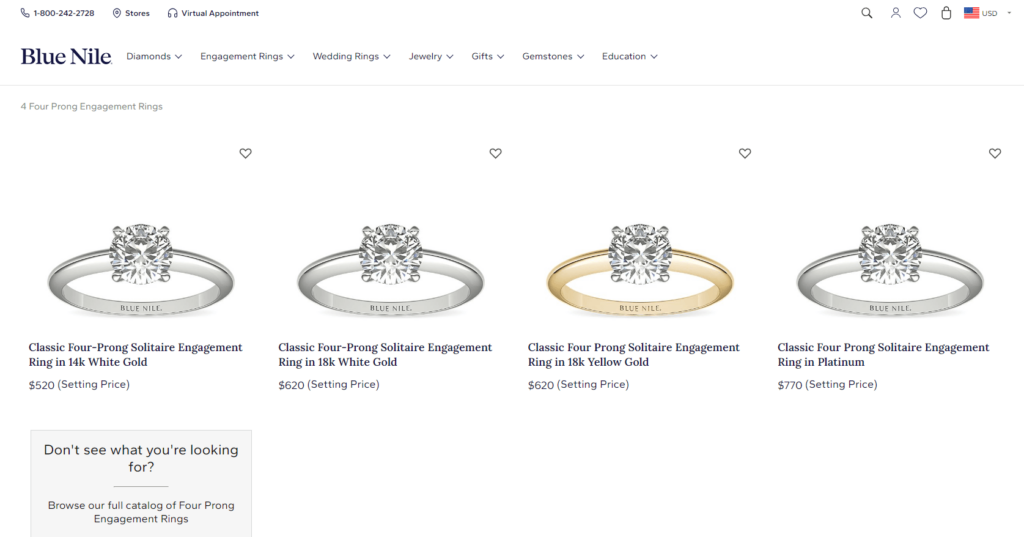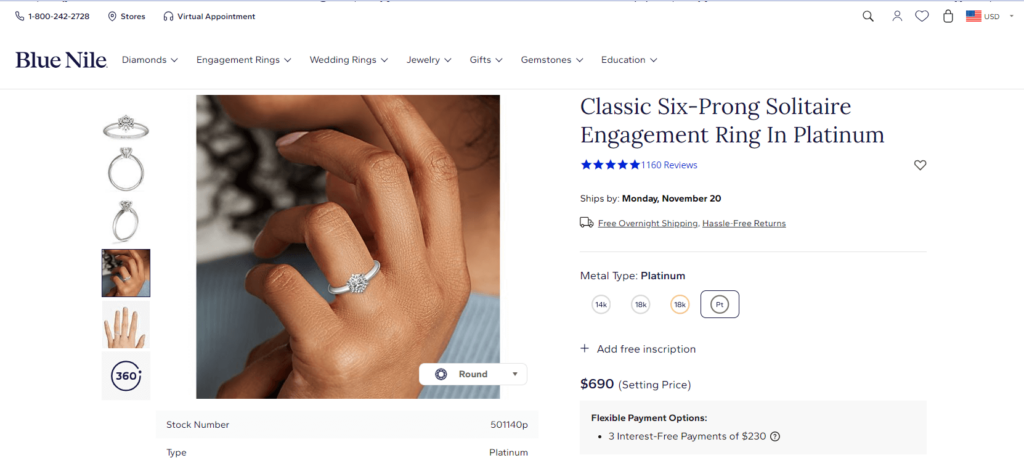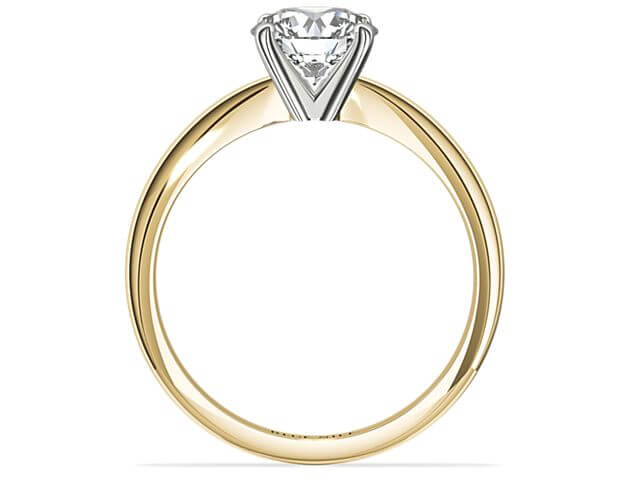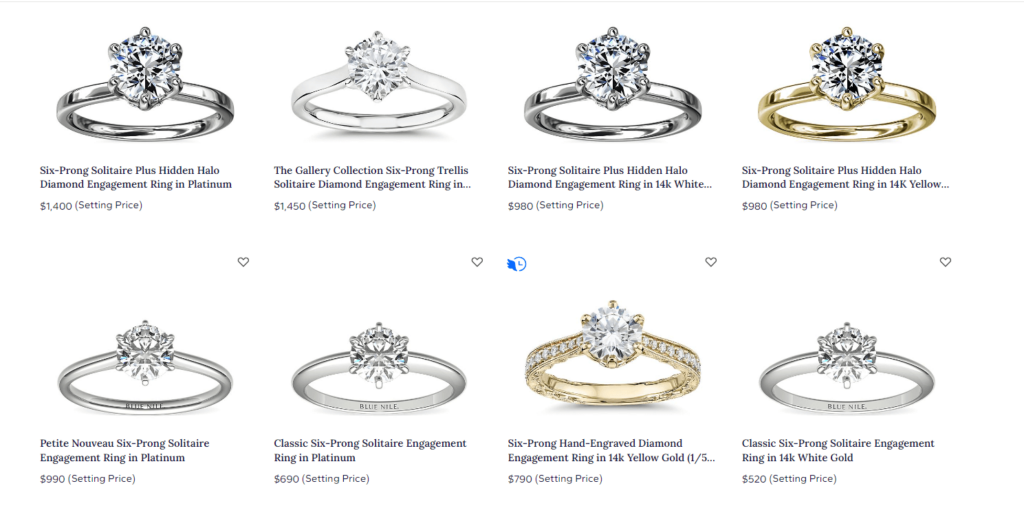Prong Setting for Engagement Rings: Ever looked at an engagement ring and wondered how that dazzling diamond stays in place? The secret is often in the prong setting.
But have you ever wondered what keeps that sparkling gem in place? Prong setting is a technique that’s as fascinating as it is functional. Many jewelers trust the setting because it holds valuable gems tightly and safeguards the sensitive parts, making it their top choice for mounting.
So, whether you’re about to make that all-important purchase or just a jewelry enthusiast, read on. BrighterGuide will delve into the details about prong settings, helping you make an informed decision that could make all the difference.
So let’s get started!
Key Takeaways
- Using a prong setting for your bling, like in an engagement ring, is classic and stylish – it’s secure but doesn’t skimp on the grace.
- These setups let the gemstones‘ sparkle and intensity shine through by making sure light can play off it from multiple directions.
- In Blue Nile, you can find a variety of styles in settings, like the sleek and secure claw prongs that can easily fit diverse diamond shapes.
In this post, we’ll explore:
What Is a Prong Setting
Engagement rings have traditionally used prong settings. These settings are both functional and gorgeous, letting tons of light in to amplify your diamond or gemstone’s brilliance and sparkle. But did you know there’s more to prong settings than meets the eye? Prong settings offer customizable and secure ways to hold diamonds and gems.
Prong rings come in plain, delicate claw, and other styles. If you’re wondering about the significance of the finger on which the engagement ring is worn, you can find more information on the engagement ring finger.
Shared prongs can highlight diamonds or bigger stones on your wedding ring. For couples looking to have matching designs, understanding matching wedding bands can be crucial. Single-prong settings, on the other hand, can give a more minimal invasion into the stone, thereby showcasing it beautifully. If you’re in the market to buy, knowing the best places to buy an engagement ring can be invaluable.
Flat prongs lay flatter against the diamond, while button prongs have a rounded look. And if you’re intrigued by the different cuts, rose-cut diamonds are a vintage-inspired choice that’s been gaining popularity.
Whether you prefer straight edges or curved edges, the versatility of these settings accommodates various diamond shapes, from carat diamonds to oval and shaped gemstones. For those looking for something truly unique, petite claw prongs offer a blend of elegance and modern design preferences.

Prong styles can totally change your ring’s vibe. If you’re into soft, curvy designs, go for rounded prongs – they hold the diamond like a gentle hug. But if you dig sharp lines and geometric feels, angled or block prongs could be your jam; they give an edgy balance to any ring design. And if you’re concerned about the financial aspect, there are options for engagement ring financing to ease the process.
If you’re on a budget, estimation of price is a crucial step in the men’s wedding band buying guide. While prong engagement rings can range in price, some retail stores offer a wide range of affordable options, like yellow gold rings with single diamonds or even looser gemstones that you can place in a setting of your choice. The retail price for these wide-band engagement rings settings varies, so it’s wise to consult a price table before making a decision.
The Benefits of a Prong Setting
One of the benefits of using a prong setting is that it allows for maximum light exposure, enhancing the luminosity and fire of the diamond. Prong settings are designed with small metal prongs that securely hold the gemstone in place while allowing light to interact with it from multiple angles. This results in a larger and more lustrous, as per GIA.

You can tweak the settings to fit your personal preferences just right. Round, double, and tab prongs are provided. Double prongs secure diamonds and seem slimmer than rounded prongs. Tab prongs, on the other hand, are distinctive and low-profile for stability and durability.
Prong settings protect and display a center diamond. Prong settings, typical in solitaire engagement rings, let diamonds shine. A four-prong setting helps a larger diamond stand out, while a six-prong setting adds stability.
Prong settings have held steady despite changes in engagement ring styles. Platinum prongs, known for their strength and elegance, can hold enormous stones. If you want an attractive design without overpowering the diamond’s beauty, use the basic prong.
How Are Prong Settings Made in the Rings
Size and design are vital when constructing ring prong settings. Prongs may be customized to match the gemstone and ring style. It’s also crucial to consider your lifestyle and tastes while choosing prongs for your engagement ring.
Size and Style
Prong settings for our rings are chosen based on size and style to complement the design and highlight the gemstone. Otherwise, called claw settings, prongs are attractive because they securely retain the diamond while letting light through.
The diamond’s security and visibility depend on prong size. Thinner prongs are delicate and attractive, while broader ones are stronger and more durable.
Prong settings can be shaped to flatter the diamond’s cut for an eye-catching look. Each prong style—rounded, pointed, or V-shaped—adds a distinctive touch to the design. Considering the durability and security of the prong setting is essential when choosing the right style for your engagement ring. Prong settings are popular for their ability to securely hold the center stone, like Asscher-cut diamonds, while allowing maximum light to interact with it, enhancing its brilliance.

When it comes to prong settings, there are various types of prongs to consider for the best engagement ring. Rounded prongs are a basic and common option, while pointed claw prongs offer a sleek and stylish look. Flat tab prongs, with their unique design and lower profile, give you both better security and lasting strength.
V-shaped prongs, with their secure grip on the diamond, and crowned prongs that bring a dash of elegance to the ring are both worth considering. With double prongs, your ring gets an extra layer of security and a neat look due to the perception of thinner prongs. V prongs, on the other hand, protect the pointed tips of a 1.5-carat diamond ring and can be paired with additional prongs for added security. But tulip prongs create a flower-shaped basket to securely hold the diamond with a unique design.
When choosing a prong setting, it’s important to consider the type of prongs that will best showcase your center stone and suit your personal style.
Are Prongs Suitable for My Engagement Ring
We often wonder if prongs are suitable for our engagement ring and how prong settings are made in the rings.
Prongs are often the go-to for engagement rings because they’ve got this classic style and really let that diamond shine. Here are a few reasons why prongs might be suitable for your engagement ring:

- Enhanced Brilliance: Prong settings allow a significant amount of light to pass through the diamond, enhancing its fire and brilliance. But the prong setting makes the diamond sparkle like crazy.
- Versatility: Prong settings can be used with most sparkly diamonds, making them a versatile option for engagement rings. Whether you prefer a round, princess, or cushion-cut diamond, prong settings can be tailored to fit your chosen stone.
- Customizable Design: Prong settings let you customize your engagement ring. The number, shape, and size of the prongs may be customized to your taste. A personalized touch that shows your originality is possible.
Prong settings are made by carving small metal tips, known as prongs, to securely hold the stone in place. The prongs start by sticking straight upwards and are then bent towards the stone to provide a snug fit. The excess metal is trimmed and finished to ensure a precise and secure setting. Crafting a prong setting needs a deft touch and an eagle eye, not just to keep the diamond safe but also to amp up its dazzle.
Deciding on the right setting for your engagement ring is a key step you need to nail. Prong engagement rings are a popular choice for their ability to secure the central diamond gracefully. The types of prong settings vary, with the classic prong settings offering a timeless look and the more modern styles providing a sleek style. The simple prong is often seen in solitaire settings, a common type that exudes elegance.
For those who prefer additional security, the 6-prong setting wraps around larger stones, ensuring they stay in place. The 4-prong setting, meanwhile, allows more of the diamond to be visible. In the realm of engagement ring design, your choice of prong setting is pivotal—it not only tweaks how the ring looks but also must sync with personal style preferences. Whether it’s the understated elegance of a solitaire ring or the intricate design elements of a halo setting, the engagement ring prongs play a crucial role in both the beauty and functionality of the ring.
The Price of Prong Settings

How much you’re willing to spend and what style catches your eye are key in determining the price range and options for engagement ring prong settings. Additionally, during your search for prong settings for engagement rings, several factors, much like those at Blue Nile, can impact the final price.
- Material: The type of metal used for the prong setting can affect the price. Precious metals like platinum and gold tend to be more expensive than silver or palladium.
- Number of prongs: The more prongs used in the setting, the higher the cost. Although more prongs on a diamond setting give extra safety, they also might hike up the price tag.
- Design complexity: Intricate designs or custom-made prong settings can come at a higher price. When a design gets more complex, it demands extra time and sweat to craft, which naturally cranks up the price.
Choosing a prong setting for your bezel engagement rings requires balancing budget and quality. Work with a trustworthy jeweler to assist you in choosing within your cost range.
Conclusion
So there you have it, the ins and outs of prong settings. From the types of prongs to consider to the benefits they offer, and even how they’re made—prong settings are more than just a way to hold your diamond; they’re a design element that can make or break the look of your engagement ring.
Are you set to lock in your ultimate choice? Whether you’re leaning towards a classic rounded prong or considering a more modern claw design, the right prong setting can enhance your diamond’s brilliance and beauty. Don’t settle for less when it comes to such a significant symbol of your love. Consult with a trusted jeweler, like Blue Nile, to explore your options and make an informed choice that you’ll cherish for a lifetime.
Sources
BrighterGuide is dedicated to providing accurate and relevant information as you explore the wonderful world of diamonds and jewelry. To this end, our writers refer to primary information sources in building each article that appears on this website. These include, but are not limited to, published news articles, government portals, research papers, and more.
- Gemological Institute of America. (n.d.). Gemological Institute Of America | All About Gemstones – GIA. https://www.gia.edu/
- Natural Diamond Grading Reports & Services. (n.d.). https://www.gia.edu/gem-lab-service/diamond-grading
- Learn How to Buy a Diamond with the GIA Diamond Buying Guide | 4Cs of Diamond Quality by GIA. (2022, July 22). GIA 4Cs. https://4cs.gia.edu/en-us/diamond-buying-guide/